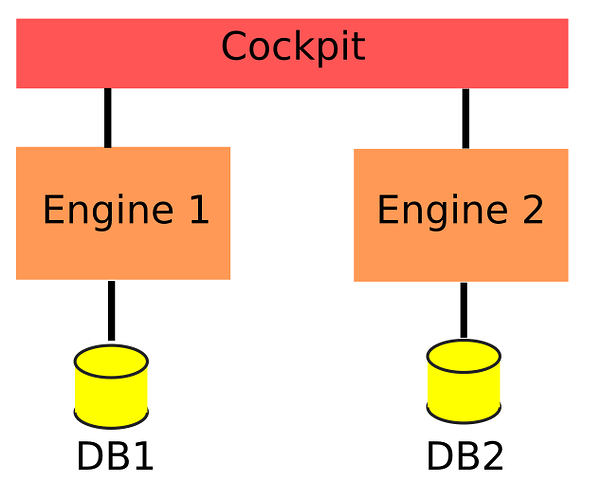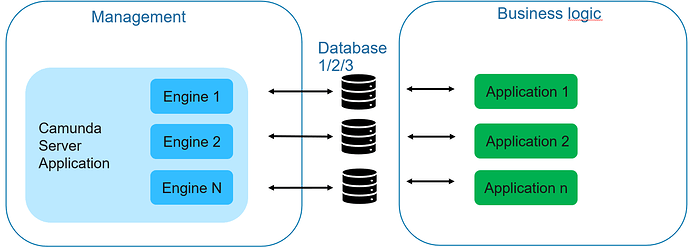Hey @Ingo_Richtsmeier ,
thanks for your answer! I had to do some more research to evaluate if the solution provided is the right one. The link you provided guided to the “right” solution.
If someone stumbles over the same problem here is what we are going to do for now:
Setup as many Camunda applications as you need, each one needs his own (external) database. Setup a (e.g.) Tomcat-Camunda application with one engine for each application you want to manage. Set the resources of each engine to one of the applications databases.
The resulting architecture looks something like that:
The left site is for monitoring and some management functions, the right side is for the business logic. Each component on the right is a spring boot application working on its own resources. For the management application the “camunda bpmn job execution” should be turned off.
Here is an example for the Tomcat configuration (Camunda v 1.17, Postgres v 13):
bpm-platform.xml
<?xml version="1.0" encoding="UTF-8"?>
default
org.camunda.bpm.engine.impl.cfg.StandaloneProcessEngineConfiguration
java:jdbc/ProcessEngine
<properties>
<property name="history">full</property>
<property name="databaseSchemaUpdate">true</property>
<property name="authorizationEnabled">true</property>
<property name="jobExecutorDeploymentAware">true</property>
<property name="historyCleanupBatchWindowStartTime">00:01</property>
</properties>
<plugins>
<plugin>
<class>org.camunda.bpm.application.impl.event.ProcessApplicationEventListenerPlugin</class>
</plugin>
<plugin>
<class>org.camunda.spin.plugin.impl.SpinProcessEnginePlugin</class>
</plugin>
<plugin>
<class>org.camunda.connect.plugin.impl.ConnectProcessEnginePlugin</class>
</plugin>
</plugins>
default
org.camunda.bpm.engine.impl.cfg.StandaloneProcessEngineConfiguration
java:jdbc/ProcessEngine1
<properties>
<property name="history">full</property>
<property name="databaseSchemaUpdate">true</property>
<property name="authorizationEnabled">true</property>
<property name="jobExecutorDeploymentAware">true</property>
<property name="historyCleanupBatchWindowStartTime">00:01</property>
</properties>
<plugins>
<plugin>
<class>org.camunda.bpm.application.impl.event.ProcessApplicationEventListenerPlugin</class>
</plugin>
<plugin>
<class>org.camunda.spin.plugin.impl.SpinProcessEnginePlugin</class>
</plugin>
<plugin>
<class>org.camunda.connect.plugin.impl.ConnectProcessEnginePlugin</class>
</plugin>
</plugins>
default
org.camunda.bpm.engine.impl.cfg.StandaloneProcessEngineConfiguration
java:jdbc/ProcessEngine2
<properties>
<property name="history">full</property>
<property name="databaseSchemaUpdate">true</property>
<property name="authorizationEnabled">true</property>
<property name="jobExecutorDeploymentAware">true</property>
<property name="historyCleanupBatchWindowStartTime">00:01</property>
</properties>
<plugins>
<plugin>
<class>org.camunda.bpm.application.impl.event.ProcessApplicationEventListenerPlugin</class>
</plugin>
<plugin>
<class>org.camunda.spin.plugin.impl.SpinProcessEnginePlugin</class>
</plugin>
<plugin>
<class>org.camunda.connect.plugin.impl.ConnectProcessEnginePlugin</class>
</plugin>
</plugins>
server.xml
<?xml version="1.0" encoding="UTF-8"?>
<Resource name="jdbc/ProcessEngine"
auth="Container"
type="javax.sql.DataSource"
factory="org.apache.tomcat.jdbc.pool.DataSourceFactory"
uniqueResourceName="process-engine"
driverClassName="org.h2.Driver"
url="jdbc:h2:./camunda-h2-dbs/process-engine;TRACE_LEVEL_FILE=0;DB_CLOSE_ON_EXIT=FALSE"
defaultTransactionIsolation="READ_COMMITTED"
username="sa"
password="sa"
maxActive="20"
minIdle="5"
maxIdle="20" />
<Resource name="jdbc/ProcessEngine1"
auth="Container"
type="javax.sql.DataSource"
factory="org.apache.tomcat.jdbc.pool.DataSourceFactory"
uniqueResourceName="process-engine1"
driverClassName="org.postgresql.Driver"
url="jdbc:postgresql://localhost:5432/application1DB"
defaultTransactionIsolation="READ_COMMITTED"
username="postgres"
password="postgres"
maxTotal="20"
minIdle="5"
maxIdle="20"
maxWaitMillis="-1" />
<Resource name="jdbc/ProcessEngine2"
auth="Container"
type="javax.sql.DataSource"
factory="org.apache.tomcat.jdbc.pool.DataSourceFactory"
uniqueResourceName="process-engine2"
driverClassName="org.postgresql.Driver"
url="jdbc:postgresql://localhost:5432/application2DB"
defaultTransactionIsolation="READ_COMMITTED"
username="postgres"
password="postgres"
maxTotal="20"
minIdle="5"
maxIdle="20"
maxWaitMillis="-1" />
<Resource name="global/camunda-bpm-platform/process-engine/ProcessEngineService!org.camunda.bpm.ProcessEngineService" auth="Container"
type="org.camunda.bpm.ProcessEngineService"
description="Camunda Platform Process Engine Service"
factory="org.camunda.bpm.container.impl.jndi.ProcessEngineServiceObjectFactory" />
<Resource name="global/camunda-bpm-platform/process-engine/ProcessApplicationService!org.camunda.bpm.ProcessApplicationService" auth="Container"
type="org.camunda.bpm.ProcessApplicationService"
description="Camunda Platform Process Application Service"
factory="org.camunda.bpm.container.impl.jndi.ProcessApplicationServiceObjectFactory" />
<!--The connectors can use a shared executor, you can define one or more named thread pools-->
<!--
<Executor name="tomcatThreadPool" namePrefix="catalina-exec-"
maxThreads="150" minSpareThreads="4"/>
-->
<!-- A "Connector" represents an endpoint by which requests are received
and responses are returned. Documentation at :
Java HTTP Connector: /docs/config/http.html (blocking & non-blocking)
Java AJP Connector: /docs/config/ajp.html
APR (HTTP/AJP) Connector: /docs/apr.html
Define a non-SSL HTTP/1.1 Connector on port 8080
-->
<Connector port="8080" protocol="HTTP/1.1"
connectionTimeout="20000"
redirectPort="8443" />
<!-- A "Connector" using the shared thread pool-->
<!--
<Connector executor="tomcatThreadPool"
port="8080" protocol="HTTP/1.1"
connectionTimeout="20000"
redirectPort="8443" />
-->
<!-- Define an SSL/TLS HTTP/1.1 Connector on port 8443
This connector uses the NIO implementation. The default
SSLImplementation will depend on the presence of the APR/native
library and the useOpenSSL attribute of the
AprLifecycleListener.
Either JSSE or OpenSSL style configuration may be used regardless of
the SSLImplementation selected. JSSE style configuration is used below.
-->
<!--
<Connector port="8443" protocol="org.apache.coyote.http11.Http11NioProtocol"
maxThreads="150" SSLEnabled="true">
<SSLHostConfig>
<Certificate certificateKeystoreFile="conf/localhost-rsa.jks"
type="RSA" />
</SSLHostConfig>
</Connector>
-->
<!-- Define an SSL/TLS HTTP/1.1 Connector on port 8443 with HTTP/2
This connector uses the APR/native implementation which always uses
OpenSSL for TLS.
Either JSSE or OpenSSL style configuration may be used. OpenSSL style
configuration is used below.
-->
<!--
<Connector port="8443" protocol="org.apache.coyote.http11.Http11AprProtocol"
maxThreads="150" SSLEnabled="true" >
<UpgradeProtocol className="org.apache.coyote.http2.Http2Protocol" />
<SSLHostConfig>
<Certificate certificateKeyFile="conf/localhost-rsa-key.pem"
certificateFile="conf/localhost-rsa-cert.pem"
certificateChainFile="conf/localhost-rsa-chain.pem"
type="RSA" />
</SSLHostConfig>
</Connector>
-->
<!-- Define an AJP 1.3 Connector on port 8009 -->
<!--
<Connector protocol="AJP/1.3"
address="::1"
port="8009"
redirectPort="8443" />
-->
<!-- An Engine represents the entry point (within Catalina) that processes
every request. The Engine implementation for Tomcat stand alone
analyzes the HTTP headers included with the request, and passes them
on to the appropriate Host (virtual host).
Documentation at /docs/config/engine.html -->
<!-- You should set jvmRoute to support load-balancing via AJP ie :
<Engine name="Catalina" defaultHost="localhost" jvmRoute="jvm1">
-->
<Engine name="Catalina" defaultHost="localhost">
<!--For clustering, please take a look at documentation at:
/docs/cluster-howto.html (simple how to)
/docs/config/cluster.html (reference documentation) -->
<!--
<Cluster className="org.apache.catalina.ha.tcp.SimpleTcpCluster"/>
-->
<!-- Use the LockOutRealm to prevent attempts to guess user passwords
via a brute-force attack -->
<Realm className="org.apache.catalina.realm.LockOutRealm">
<!-- This Realm uses the UserDatabase configured in the global JNDI
resources under the key "UserDatabase". Any edits
that are performed against this UserDatabase are immediately
available for use by the Realm. -->
<Realm className="org.apache.catalina.realm.UserDatabaseRealm"
resourceName="UserDatabase"/>
</Realm>
<Host name="localhost" appBase="webapps"
unpackWARs="true" autoDeploy="true">
<!-- SingleSignOn valve, share authentication between web applications
Documentation at: /docs/config/valve.html -->
<!--
<Valve className="org.apache.catalina.authenticator.SingleSignOn" />
-->
<!-- Access log processes all example.
Documentation at: /docs/config/valve.html
Note: The pattern used is equivalent to using pattern="common" -->
<Valve className="org.apache.catalina.valves.AccessLogValve" directory="logs"
prefix="localhost_access_log" suffix=".txt"
pattern="%h %l %u %t "%r" %s %b" />
</Host>
</Engine>
The original examples are provided by Camunda. You can find different server setups here .
You may want to edit the plugins of the engines.
Greetings !

